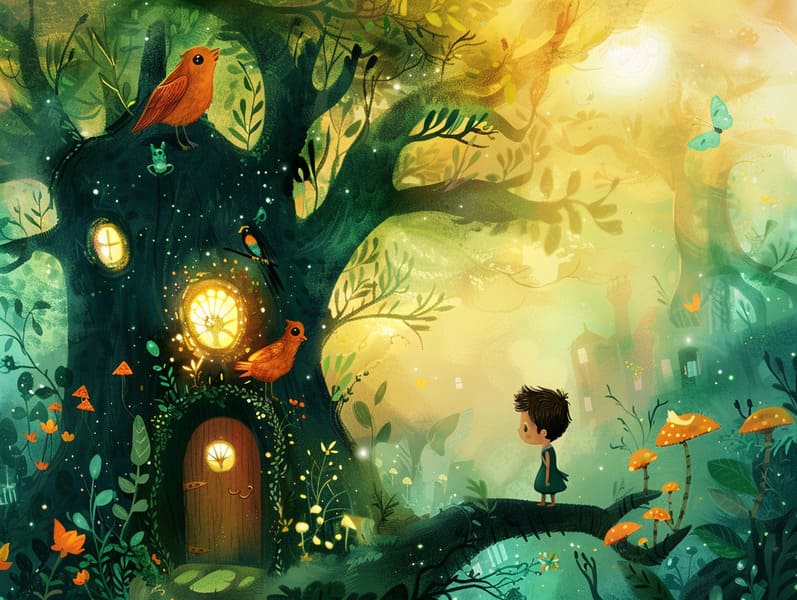The Creation of Grimm's Fairy Tales and Its Unceasing Charm.
The Creation of Grimm's Fairy Tales and Its Unceasing Charm.
Blog Article

Fairy tales for kids have enduring presence. These stories have been narrated from one generation to the next millennia before they were ever inscribed. They originated from a variety of traditions, including European traditions. They were initially disseminated among adults, often carrying themes and messages aligned with the societal norms and beliefs of the time.
The famous Grimm duo, Jacob and Wilhelm, were among the first to collect and release many of these beloved narratives. Their published works, "Grimm's Fairy Stories," included stories like "The Little Glass Slipper," "Little Brother and Little Sister," and "Snow White," which have since become hallmarks in the world of iconic fairy tales. Similarly, H. C. Andersen's fantastical tales, such as "The Mermaid," and "The Ugly Duckling," have gained the love worldwide, guaranteeing their place in the pantheon of iconic fairy tales.
Though they are centuries old, fairy tales remain as applicable as ever, especially as kids' bedtime tales. These enchanting tales are now available in many formats, including vividly illustrated books, charming animations, and digital fairy tales.
Their continued relevance can be connected to several fascinating points:
Significant Morals: Old fairy tales often provide important moral lessons. Stories like "The Story of the Boy Who Cried Wolf" teach the significance of honesty, while "The Story of the Tortoise and the Hare" point out the merits of perseverance and meekness. These narratives offer children clear distinctions between ethical and unethical, molding their moral compass in a gentle yet important way.
Kindness and Comprehension: Classic fairy tales frequently illustrate heroines facing challenges and problems, prompting young listeners to sympathize with their struggles and celebrate their triumphs. For instance, "Beauty and Her Beast" points out the merit of looking beyond appearances to acknowledge the true being of a individual, strengthening tenderness and understanding.
Cultural Perception: Many timeless fairy tales are infused with the cultural contexts from which they blossomed. Understanding these tales can provide fascinating glimpses into different traditions, enhancing a sense of cultural respect and respect.
Fantasy and Innovation: The mythical elements in old fairy tales—talking animals—fuel children’s innovative ideas. These stories carry readers to fantasy realms, stimulating innovative ideas and a sense of marvel that remains a lifetime.
Old fairy tales are not only charming but also instructive. They function as entrancing tools in strengthening various mind and heart abilities in kids. When traditional fairy tales are read aloud, they strengthen language acquisition by offering new terms and meanings and complex sentence structures. This practice check it out also nurtures hearing abilities and attention, as little ones listen intently, ready to see what happens next.
Furthermore, deliberating the themes and characters of timeless fairy tales can enhance evaluative skills and intellectual skills. Kids are instructed to discern patterns, make predictions, and catch on to cause and effect. These conversations also aid little ones convey their thoughts and feelings, boosting their emotional intelligence.
In today’s cyber age, the proliferation of digital storybooks has made these tales more available than ever. Online platforms and software offer large libraries of famous fairy tales that can be enjoyed or listened on anytime, anywhere. Fairy tales read out loud are particularly widespread, giving an delightful method for kids to relish these mesmerizing stories. Sound books and read-to-me stories take characters and settings to life, often supplemented by entrancing soundtracks and instrumentals that intensify the storytelling journey.
The timeless fascination of old fairy tales lies in their ability to transform to present eras while sustaining their main lessons. Contemporary renditions of these stories often showcase more different characters and modern settings, making them understandable to today’s audience. However, the underlying themes of fortitude, warmth, and fairness remain unchanged, continuing to appeal to kids of all ages.
Traditional fairy tales also offer a sense of ease and comprehensibility. They share a orderly narrative with a clear beginning, middle, and end, often wrapping up with the culmination of conflicts and the triumph of honesty over deceit. This certainty can be relieving for the young, making known a sense of firmness in an shifting world.
Old fairy tales continue to enthrall and edify new generations, maintaining their majesty and importance in modern society. As children's bedtime stories, they bring a perfect blend of captivation and insight, nurturing moral values, empathy, and creativity. The proliferation of digital fairy tales and the favor of fairy tales narrated validate that these traditional fairy tales remain attainable to new generations.
By holding onto and narrating these narratives, we continue to glorify the rich tapestry of inventiveness and cultural heritage. Whether you are delving into a vibrantly illustrated book, viewing a online library, or listening on an narrated book, the loveliness of ancient fairy tales is always within reach. These narratives point out of the unwavering strength of narratives and its ability to bond us across time and space.
Whether you are enjoying a colorful picture book, experiencing a electronic library, or hearing an spoken story, the attraction of ancient fairy tales is always within reach.
These narratives highlight of the unending ability of narratives and its ability to draw us together across epochs and places, casting a charm that delights and instructs alike.